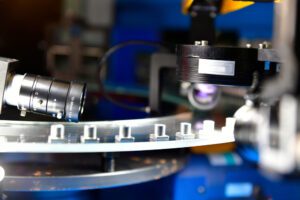In today’s fast-paced industrial landscape, the demand for smarter, more efficient manufacturing processes has never been greater. As industries race toward digital transformation and full automation, visual intelligence technologies are taking center stage.
Among these, machine cameras are emerging as a critical enabler of intelligent production lines—bringing precision, speed, and insight to every stage of manufacturing.
These advanced imaging systems are no longer reserved for high-end applications. The best industrial cameras are now accessible to operations of all sizes, offering robust solutions for inspection, sorting, robotic guidance, and quality control. With real-time data capture and machine vision integration, manufacturers can identify defects, reduce waste, and increase output—all without human intervention.
For manufacturers looking to future-proof their operations, investing in machine vision is no longer optional. It’s a strategic imperative. And that’s where this leading industrial imaging solutions provider steps in—offering a wide range of high-performance industrial cameras designed to meet the specific needs of automated production environments.
The evolution of machine vision in manufacturing
The journey from manual assembly lines to automated smart factories has been shaped by several key technologies—robotics, IoT, AI, and machine vision. Among them, vision systems serve as the “eyes” of the operation, providing the visual context machines need to make autonomous decisions.
Initially, machine cameras were used in simple 2D applications, such as barcode scanning and presence detection. Today, they have evolved into complex imaging tools capable of high-resolution 3D inspection, AI-powered analysis, and real-time feedback integration with robotic systems. This leap in capabilities has transformed them from peripheral tools into core components of the industrial ecosystem.
Why machine cameras are critical to modern production lines
Machine cameras play a pivotal role in enabling the intelligent, interconnected factory. Here’s why:
1. Precision inspection
Machine cameras allow for pixel-perfect product inspection, ensuring that every item meets exacting quality standards. Whether it’s detecting micro-cracks in glass or verifying solder joints on a PCB, vision systems offer a level of consistency and accuracy unmatched by human inspectors.
2. Real-time feedback
Integrated with AI and edge computing, these cameras can process images instantly, providing real-time feedback to control systems. This means immediate corrections can be made to avoid costly rework or downtime.
3. Automation enablement
In robotic guidance systems, machine cameras serve as the navigational tools for industrial robots. They help robots identify objects, determine orientations, and execute tasks with high accuracy, allowing for greater flexibility on the production floor.
4. Data-rich insights
Beyond just imaging, the best industrial cameras generate valuable data that can be used for predictive maintenance, performance monitoring, and process optimization. Vision analytics is fast becoming a pillar of industrial AI strategies.
Key industries embracing machine camera technology
Virtually every industrial sector stands to benefit from machine vision. Here are some leading adopters:
Automotive: From surface inspections to component alignment, machine cameras are ensuring safety and compliance throughout the vehicle assembly process.
Pharmaceuticals: High-speed vision systems validate packaging integrity and label accuracy, minimizing recalls and ensuring regulatory compliance.
Electronics: Precision is everything in semiconductor manufacturing, where vision systems detect the tiniest faults invisible to the naked eye.
Food & beverage: Machine vision helps with sorting, packaging, and ensuring hygiene standards, particularly in high-volume environments.
Logistics: Cameras power automated sortation systems, verifying barcodes and labels to streamline warehouse operations.
Choosing the best industrial cameras for your factory
Selecting the right camera solution depends on several factors—image resolution, frame rate, lighting conditions, environmental challenges, and integration requirements. A tailored solution ensures optimal performance, lower total cost of ownership, and scalable deployment.
When evaluating vendors, look for:
Proven expertise in industrial automation
Support for integration with PLCs, robotics, and vision software
Long product life cycles and industrial-grade reliability
Technical support and after-sales service3
Read more:
From Assembly to Automation: How Machine Cameras Are Powering Intelligent Production Lines


